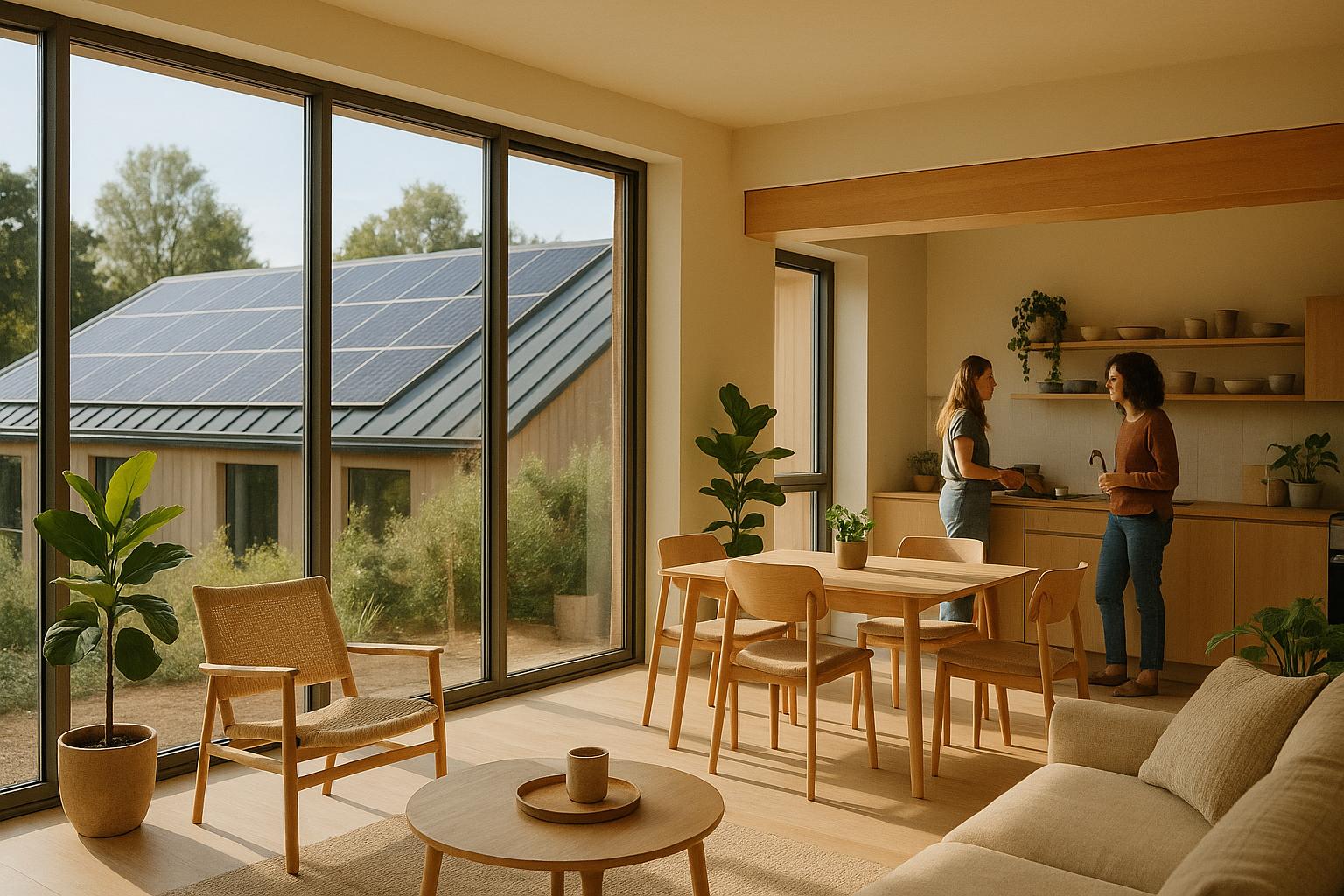Struggling with remote work challenges like loneliness or finding a productive workspace? Coliving spaces might be the solution you're looking for.
Here’s why coliving works for remote workers:
- Community: Connect with like-minded professionals to combat isolation.
- Work-Ready Features: Enjoy coworking spaces, ergonomic setups, and high-speed internet (100 Mbps+).
- Flexibility: Short-term stays (as little as 30 days) let you move freely without long-term leases.
- Cost Savings: All-inclusive pricing ($100–$500/week) covers rent, utilities, internet, and furnishings - cheaper than traditional rentals.
- Work-Life Balance: Relaxation zones, fitness centers, and social events help you recharge.
Coliving blends affordable housing with shared workspaces and a strong sense of community, making it ideal for digital nomads and remote workers. With options worldwide, platforms like Coliving.com simplify finding the perfect space.
Work-Ready Features in Coliving Spaces
Dedicated Work Areas
Coliving spaces are stepping up their game by offering coworking areas tailored for productivity, often rivaling traditional office setups.
Take Nine Coliving in Tenerife, Spain, for example. It boasts a coworking area with 14 individual desks, plus access to a rooftop terrace and garden - perfect for those who enjoy working outdoors. Similarly, Evolve Coliving in Malta provides coworking facilities within its villa, offering residents a variety of workspaces to suit their needs.
These spaces often include ergonomic seating, adjustable desks, and even private offices for those moments when you need to focus. Whether you're collaborating on a group project or tackling a solo task, these setups cater to different work styles. And of course, all of this is supported by strong internet and reliable tech infrastructure to keep things running smoothly.
High-Speed Internet and Tech Setup
Reliable internet is non-negotiable for remote work, and top-tier coliving spaces make sure you're covered. You can expect speeds of at least 100 Mbps for both uploads and downloads, which is more than enough for video calls, file transfers, and multitasking across multiple devices.
| Activity | Required Speed | Essential Equipment |
|---|---|---|
| Video Conferencing | 5–25 Mbps | HD webcam, noise-cancelling headphones |
| File Sharing | 10 Mbps | Cloud storage access |
| General Work | 5–25 Mbps | Secondary monitor, ergonomic keyboard |
In addition to fast internet, these spaces are equipped with plenty of power outlets, backup power solutions to avoid disruptions, and even signal boosters for strong cellular reception. Many also provide backup hotspots to ensure you're never left without a connection. For video calls, dedicated meeting areas with proper lighting and minimal noise make it easy to stay professional without hunting for a quiet corner.
Extra Features for Work-Life Balance
The best coliving spaces understand the importance of maintaining a balance between work and downtime. Having clear boundaries between the two can boost productivity and prevent burnout. Sundesk Coliving in Morocco, for instance, offers relaxation areas completely separate from workspaces, giving residents a chance to unwind.
Spaces like Sundesk and Outsite take this concept further by blending work zones with amenities that encourage relaxation and wellness. Outsite’s properties, located in destinations like Bali, Costa Rica, and California, often feature swimming pools, fitness centers, and on-site cafes. These amenities make it easy to step away from work and recharge.
To round it all out, many coliving spaces offer extras like fully equipped kitchens for meal prep, communal lounges for socializing, and quiet zones for relaxation. These thoughtful touches help create a rhythm that balances work and personal life, making the remote work experience both productive and enjoyable.
Building Community and Fighting Isolation
Making Social Connections
Remote work can sometimes feel lonely, especially if you’re constantly on the move or working from home without much interaction. Coliving spaces tackle this head-on by creating environments where connections naturally form. Unlike typical apartments where you might barely know your neighbors, coliving brings together people with shared lifestyles and work habits.
Everyday moments in shared spaces like kitchens, lounges, and work areas make it easy to meet others. Joe Hallett, who manages the coliving space at Balu Living in Medellin, captures it well:
"It's about different nationalities coming together, exploring Medellin and making memories."
Many coliving spaces take it a step further by organizing social activities to help residents connect. For instance, Casa Netural in Italy hosts a walking tour of Matera that wraps up with an aperitivo, offering a relaxed way for residents to bond. These events create opportunities for meaningful interactions without the awkwardness of forced introductions.
What makes these spaces even more enriching is the diversity of people you meet. Whether it’s learning about work styles from another culture, trying new dishes during communal dinners, or swapping travel stories, the variety of experiences adds depth to the social connections. These shared moments often lead to professional collaborations and skill exchanges.
Skill-Sharing and Professional Networking
Coliving isn’t just about making friends - it’s also a hub for professional growth. Living alongside other remote professionals opens up countless chances to learn. One resident might be a UX designer offering feedback on your project, while another could be a marketing pro sharing tips over dinner.
"Skill-sharing in coliving spaces is about residents exchanging knowledge and learning together. It builds community, fosters connections, and promotes personal growth." - Coliving Guide
Many coliving spaces formalize this exchange through workshops and skill-sharing sessions. These events cover a range of topics, from technical skills like web development and SEO to business-focused areas like project management and public speaking. The formats vary: some spaces host hands-on workshops, while others organize mentoring circles or informal knowledge-sharing events.
| Skill Category | Popular Topics | Learning Format |
|---|---|---|
| Digital Skills | Web development, UX design, SEO | Workshops |
| Business | Project management, public speaking | Mentoring circles |
| Remote Work | Virtual collaboration, productivity tools | Hands-on training |
Beyond skill-building, coliving spaces are fertile ground for networking. Living in close quarters with other professionals creates opportunities for partnerships and collaborations that might not happen in traditional work settings. Many remote workers have found project collaborators or stumbled upon new business ventures thanks to these connections.
Supporting Mental Health
The benefits of coliving go beyond work and socializing - it also supports mental well-being. Remote work, while flexible, can come with challenges like loneliness and a lack of community. Digital nomads, in particular, often struggle to adjust to new places without a built-in support system.
A strong coliving community can ease these challenges, offering a sense of stability and connection. For example, a London-based coliving space reported that 68% of its residents felt their social lives improved thanks to organized events. Community managers play a key role here, curating events, introducing residents to one another, and ensuring the atmosphere stays welcoming and inclusive.
This combination of events, shared experiences, and consistent support fosters a sense of belonging that’s often missing in remote work setups. Whether it’s finding someone to share lunch with on a tough day or joining a group to explore the city on weekends, these connections provide the emotional foundation needed to make remote work sustainable over the long haul.
Cost and Flexibility Benefits of Coliving
All-Inclusive Pricing
One of the standout perks of coliving for remote workers is the all-in-one pricing model. With coliving, essentials like high-speed internet, utilities, furniture, and cleaning services are bundled into a single monthly fee. This setup not only simplifies budgeting but also eliminates surprise expenses.
This structure is especially helpful for freelancers and remote workers with variable incomes. Instead of stressing over fluctuating electricity bills or unreliable internet during a crucial client call, residents can focus on their work, knowing these necessities are already taken care of.
Coliving also eases the financial burden of moving. Traditional rentals often require significant upfront costs, which can be challenging for those frequently relocating or just starting their remote work journey.
| Expense Category | Traditional Housing | Coliving Space |
|---|---|---|
| Security Deposit | 1-2 months' rent | Minimal or none |
| Furniture | $3,000-$5,000 upfront | Included |
| Utilities Setup | $200-$500 initial fees | Included |
| Internet Installation | $50-$150 setup fee | Included |
Short-Term and Flexible Contracts
For remote workers, flexibility is key. Projects can end early, contracts might get extended, or new opportunities in a different city can pop up unexpectedly. Coliving spaces cater to these needs by offering both short-term and long-term contracts, making it easier for residents to adapt to their changing circumstances.
Unlike traditional leases that lock tenants into year-long agreements and penalize early exits, coliving spaces allow for adjustments without hefty fees. Need to extend your stay by a few weeks? No problem. Want to move to another property in the same network? That’s often just as easy. This flexibility is a game-changer for digital nomads who might fall in love with a city or need to relocate quickly for work.
This adaptable approach ensures remote workers can embrace new opportunities without worrying about housing complications.
Cost Savings vs. Regular Rentals
Beyond convenience, coliving often proves to be a more affordable option compared to traditional rentals. The savings are particularly noticeable in major cities where remote workers frequently settle. For example, digital nomads in New York City can save up to $1,701 per month by choosing coliving over renting a studio apartment.
The financial benefits extend beyond coastal hubs. In Atlanta, coliving options start at $719 per month, while the average one-bedroom apartment costs around $1,714. Near universities, the numbers are equally compelling. In Los Angeles, coliving near USC typically costs 30-40% less than renting a one-bedroom apartment. Similarly, near the University of Washington in Seattle, coliving rents are 25-35% lower than traditional options.
These savings aren’t just about lower rent. Coliving spaces include utilities, internet, and furniture, while shared amenities like fully equipped kitchens, workspaces, and social areas reduce individual costs even further.
For remote workers who prioritize experiences and professional growth over accumulating possessions, coliving offers a practical and cost-effective housing solution. It frees up resources to invest in career development, travel, or whatever new opportunity comes next.
How to Choose the Right Coliving Space for Remote Work
Checking Work-Ready Features
When evaluating a coliving space, it’s essential to ensure it’s equipped for remote work. Start by checking the internet connectivity - this is non-negotiable. You'll need speeds of at least 100 Mbps for both upload and download to handle video calls, large file transfers, and cloud-based tools without hiccups. To confirm, ask the host for a recent speed test screenshot or test it yourself using tools like Speedtest.net or Fast.com. If possible, check the connection at different times of the day, as network speed can drop during peak usage hours.
Here’s a quick checklist of key features to look for:
| Feature | Minimum Requirements |
|---|---|
| Internet Speed | 100 Mbps up/down |
| Workspace | Dedicated desk area with ergonomic setup |
| Meeting Space | Private area for video calls |
| Power Setup | Multiple outlets and backup power options |
| Phone Reception | Strong cellular signal or signal booster |
Beyond internet speed, a proper workspace is crucial. Look for a dedicated desk with an ergonomic setup and sufficient outlets. Many coliving spaces now offer private work pods or quiet areas tailored for video calls or focused tasks. Additionally, ensure there’s a strong cellular signal or a signal booster in case you need to rely on mobile data as a backup. A well-equipped workspace can make all the difference in staying productive while working remotely.
Location and Access Factors
Once you’ve confirmed the workspace is up to par, it’s time to evaluate the location. The neighborhood surrounding your coliving space plays a big role in both your productivity and overall experience. Ideally, you want a space located in a lively area with easy access to key amenities like public transportation, restaurants, and coworking spaces.
Many remote workers prefer coliving spaces in central neighborhoods where shops, cafes, and transit options are within walking distance. This setup not only supports your work needs but also encourages exploration of your new surroundings. Plus, having backup workspaces nearby, like coworking hubs or quiet cafes, adds flexibility to your routine.
Safety is another priority. Choose neighborhoods that are secure and offer access to the experiences you’re looking for, whether that’s local attractions, outdoor activities, or networking events. For many, the appeal of coliving lies in the chance to travel and immerse themselves in new environments, so pick a location that aligns with both your work and lifestyle goals.
Using Platforms Like Coliving.com
After narrowing down your options based on workspace and location, a reliable platform can simplify the search process. Coliving.com is a great resource, connecting remote workers to over 1,700 coliving spaces in 350+ cities across 65+ countries. The platform’s fully online process makes it easy to find, compare, and book spaces, cutting out the stress of international housing searches.
Coliving.com caters specifically to remote workers by highlighting work-friendly features in its listings. You can filter spaces based on internet speed, workspace availability, and other essentials for productivity. With over 39,000 rooms available, there’s a wide range of options to fit various budgets and preferences. Prices start as low as $100 per month, and the all-inclusive pricing includes utilities, Wi-Fi, and cleaning services, giving you a clear picture of your monthly costs upfront.
One standout feature for remote workers is the platform’s money-back guarantee and flexible cancellation policy, which is ideal if your plans change or the space doesn’t meet your expectations. Coliving.com also partners with over 700 hosts worldwide, ensuring consistent quality and smooth communication. This network of properties often allows you to move between spaces in the same city or transfer to a new location if needed, making it a versatile choice for dynamic work situations.
Why Coliving Works for Remote Workers
Coliving simplifies life for remote workers by combining living and working spaces into a single, hassle-free package. With over 35 million digital nomads around the globe, the need for flexible, work-friendly accommodations is only increasing.
These spaces are designed to boost productivity with features like dedicated workstations, reliable high-speed internet, and ergonomic furniture. It’s all set up so you can focus entirely on your work without worrying about the logistics of creating a functional workspace.
But coliving isn’t just about work - it’s also about connection. Research shows that 89% of employees feel happier and 83% less lonely in coworking environments. As Ben Smith, CEO of Tribe, explains:
"We help you make friends."
This sense of community is more than a perk - it’s vital. Social isolation has been linked to a nearly 26% higher risk of premature death, making these shared spaces a lifeline for remote workers looking to stay connected and supported.
On top of the productivity and social benefits, coliving offers financial advantages that are hard to ignore. With all-inclusive pricing starting at $100 per month on Coliving.com, you get furnishings, utilities, Wi-Fi, and cleaning - all without the hassle of deposits, long-term leases, or hidden fees. For digital nomads, this kind of flexibility isn’t just a bonus - it’s essential for sustaining their way of life.
FAQs
How do coliving spaces provide reliable internet for remote workers?
Coliving spaces cater to remote workers by providing high-speed Wi-Fi with reliable connections, often boasting speeds over 100 Mbps. This kind of setup makes video calls smooth, streaming hassle-free, and handling data-heavy tasks much easier.
To keep productivity on track, these spaces also include dedicated work areas equipped with ergonomic furniture. Many also offer communal spaces designed for collaboration. Plus, they emphasize fast customer support to tackle any connectivity hiccups, ensuring remote workers can stay productive without missing a beat.
What should I look for in a coliving space as a remote worker?
When choosing a coliving space for remote work, there are a few essentials to keep in mind: reliable internet, comfortable workspaces, and a supportive community. A solid internet connection - think speeds of at least 100 Mbps - is non-negotiable for smooth video calls and staying productive. And don’t overlook the importance of ergonomic desks and chairs; they’re game-changers for staying comfortable during those long workdays.
Community matters, too. Shared spaces and organized events can make it easier to meet people who share your interests or work style. On top of that, flexible lease options and all-inclusive pricing (covering utilities, Wi-Fi, and cleaning) make life simpler. Lastly, don’t forget about safety - features like secure access and pre-screened roommates can go a long way in giving you peace of mind.
How do coliving spaces help remote workers feel less isolated?
Coliving spaces aim to build a strong sense of community, which makes them a great choice for remote workers who might struggle with feelings of isolation. Shared areas like kitchens, lounges, and coworking spaces naturally bring people together, creating opportunities for genuine social connections.
On top of that, many coliving spaces organize events, workshops, and wellness activities. These gatherings give residents a chance to bond, exchange ideas, and form friendships. This kind of supportive atmosphere doesn’t just help with loneliness - it also encourages collaboration and creates a feeling of belonging that can make working remotely much more enjoyable.






